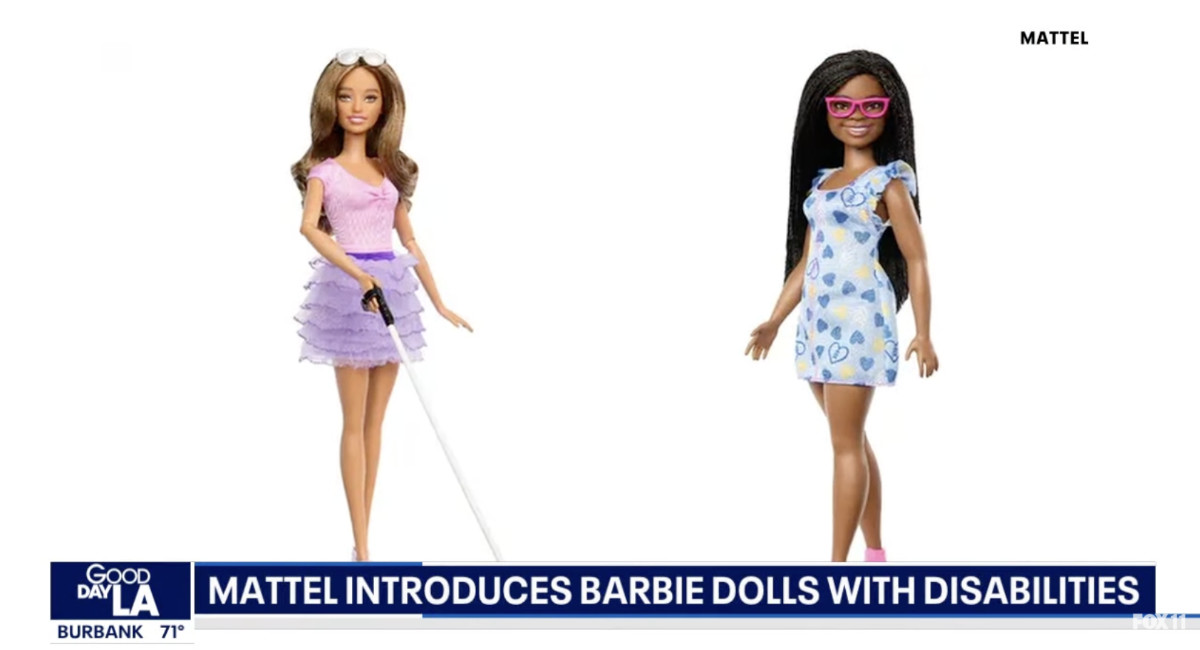Mattel has added two new dolls to its inclusive Fashionistas line: a Black Barbie with Down syndrome, and a blind Barbie, furthering the company’s campaign to provide “endless possibilities for storytelling and fashion exploration” through the Barbie Fashionistas line.
Last year, the first ever Barbie with Down syndrome was introduced, created with a partnership through the National Down Syndrome Society (NDSS). The doll with Down syndrome has a blue-and-yellow butterfly-patterned dress, a pink necklace with three arrows, and pink ankle foot orthoses (AFOs). Her sneakers also had a zipper detail, making them come on and off easily. The doll also has a shorter frame and longer torso, almond-shaped eyes, a flat nasal bridge, small ears, and a palmar crease – single line across the palm – which are all common physical characteristics of Down syndrome. NDSS also had a medical professional help review the doll for the most accuracy possible.
Previous dolls included in the Fashionistas line include dolls with vitiligo, limb differences, and hearing aids, as well as a doll without hair, and dolls that use wheelchairs. Altogether, there are over 175 varieties of skin tone, eye color, hair color and texture, body types, disabilities and fashions children can choose from.
View this post on Instagram
Mattel again worked with NDSS to create the Black Barbie with Down syndrome, consulting Black Down syndrome self-advocates to ensure accurate representation. Her dress is again blue and yellow, but this time patterned with hearts, and her hair is textured and braided – a request made by the Black Down syndrome self advocates.
“NDSS is thrilled to introduce a second Barbie doll with Down syndrome. Having this doll launched alongside the new Barbie doll with Blindness marks another important step in expanding representationfor the disability community,” Kandi Pickard, President and CEO of NDSS, said in a press release. “We are proud to partner with Barbie as they grow to reflect our diverse and beautiful world.”
The doll also has many of the same physical characteristics of the previous Barbie with Down syndrome, but this time also comes with pink glasses, as many people in the Down syndrome community do have various vision difficulties.
People with disabilities, including Down syndrome, are often targeted for abortion or inferior medical care, and they are often excluded or ignored among those in the general public… which then reinforces negative cultural stereotypes and associations, thereby creating a cycle in which a prenatal disability diagnosis is seen as something to fear and mourn and, therefore, abort. Bioethicists in Iceland, which has a nearly-100% abortion rate for babies with Down syndrome, have admitted that part of the problem is a lack of interaction with people who have disabilities.
“Personally, I think the best thing we can do is to have people with intellectual disability and people with Down syndrome … publicly visible,” Ástríður Stefánsdóttir, a medical doctor and a professor in applied ethics at the University of Iceland, said. “This changes the way people think [through] personal histories, personal encounters.”
View this post on Instagram
For the first ever blind/vision-impaired Barbie, Mattel partnered with the American Foundation for the Blind (AFB). The package has Braille on it, and can be opened more easily by vision-impaired children; these features will now be implemented on all of the Barbie Fashionistas line moving forward.
The doll herself comes with a white and red cane with a marshmallow tip and a pair of functional sunglasses, as bright sunlight can be painful or uncomfortable for people who are blind or are vision-impaired. Her arms have bendable elbows, so she is able to use her cane, and her eyes are designed with an “eye gaze facing slightly up and out” to represent the appearance of some individuals with blindness or vision impairment.
Even the clothes were designed with sensory-rich play in mind, as the doll features a satiny pink blouse and ruffled skirt for tactile play, and a brightly colored, high-contrast hook and loop closure on the back of her top and elastic waistband on her skirt so she can be changed easily.
“It was an honor to collaborate with Barbie on the development of the blind Barbie doll,” Eric Bridges, AFB CEO and President, said in a press statement. “By increasing representation and promoting awareness about the experiences of blind individuals and those with low vision, our shared goal is to inspire boundless opportunities for everyone, ultimately leading to a world of greater accessibility and inclusion.”







